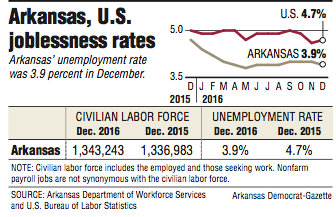Arkansas' unemployment rate slipped to 3.9 percent in December from 4 percent in November, the U.S. Bureau of Labor Statistics said Friday.
The state's unemployment rate is well below the national rate in December of 4.7 percent.
"Sub-4 percent unemployment is absolutely amazing," said Kathy Deck, director of the Center for Business and Economic Research at the University of Arkansas in Fayetteville. "We continued to see a good, strong, thriving Arkansas economy in December."
Last year there was a slowdown in the state's job growth compared with 2015, said Michael Pakko, chief economist at the Institute for Economic Advancement at the University of Arkansas at Little Rock.
Only 3,000 nonfarm payroll jobs were added in Arkansas last year, compared with 27,100 jobs added in 2015.
"We ended [2016] with fairly flat payroll growth or definitely a slower growth year than 2015 was," Pakko said.
The slow growth in nonfarm payroll jobs is not good news, Deck said.
"It's a trend that's happened for several months," Deck said.
The state began 2016 with an unemployment rate of 4.4 percent in January and ended with a rate of 3.9 percent, said Susan Price with the Arkansas Department of Workforce Services.
"The unemployment rate steadily decreased in early 2016 before becoming fairly stable in the latter half of the year," Price said in a prepared statement.
Compared with December 2015, there were 6,260 more Arkansans in the labor force, about 17,500 more employed Arkansans and about 11,200 fewer Arkansans who were unemployed.
Nonfarm payroll jobs are not synonymous with the civilian labor force.
The size of Arkansas' labor force -- the sum of employed and unemployed workers in the state -- is determined from a monthly survey of about 800 households in the state.
A more comprehensive poll of the number of jobs, as opposed to the number of workers, is taken from nonfarm payroll data submitted monthly by thousands of Arkansas companies.
There were six business sectors with gains in jobs compared with December last year and five sectors with declines.
But few of the sectors moved significantly.
The educational and health services sector added 5,300 jobs over the past year, and the professional and business services sector grew by 4,000 jobs.
But five of the sectors -- financial activities, government, information, leisure and hospitality, and other services -- changed less than 1,000 jobs each in the past 12 months.
The trade, transportation and utilities sector lost 3,200 jobs last year. The sector includes retail and wholesale trade as well as transportation.
The decline is simply an illustration of the way Arkansans shop, Deck said.
"There's an ongoing structural change in that sector from physical sales to online sales," she said. "That just changes the distribution of [the employees]. You need fewer cashiers and more truck drivers."
Manufacturing continued its decline, losing 2,000 jobs in 2016. From a peak of 247,300 jobs in 1995, the sector has lost more than 94,000 jobs.
"A lot of the decline in manufacturing is nationwide and has been going on for well over a decade," Pakko said. "It's in part due to technology -- the automation of the manufacturing process -- and in part due to globalization."
It is an uphill battle to substantially increase manufacturing employment, Deck said.
"It will be interesting from an economic perspective to see if there are new lines of business and new kinds of production happening in the United States," Deck said. "But I don't have a whole lot of confidence in the short term that we'll see a lot of increase in manufacturing employment in the sectors we already have."
The data from other states that normally accompany the information on Arkansas employment will not be released by the Bureau of Labor Statistics until next week.
Business on 01/21/2017
